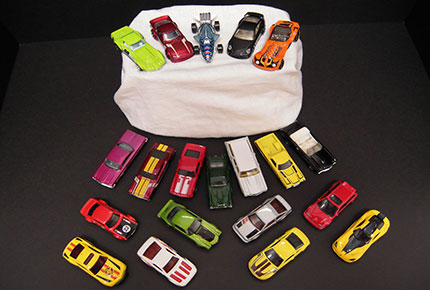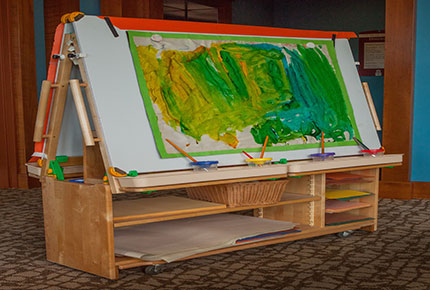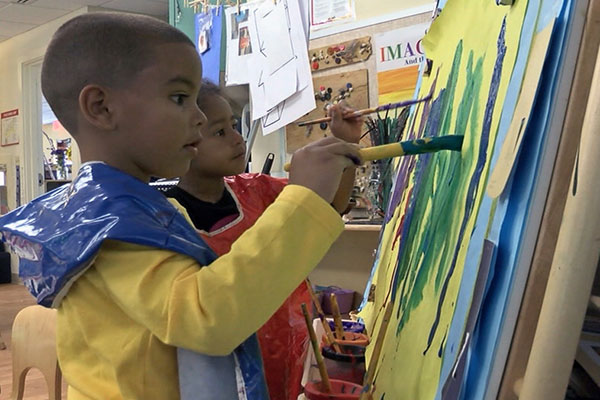2014 TIMPANI Toy Study
(This video has captions. You can turn them on by clicking the CC icon at the bottom of the video.)
Download a printable transcript.
Dr. Elsa Núñez (President): Hello, I’m Elsa Núñez, President of Eastern Connecticut State University. The TIMPANI toy study is CARRIED OUT by faculty and students working together to help early childhood professionals and parents discover which toys best help children learn. I hope you find this year’s results as interesting as I do.
Methods
Dr. Jeffrey Trawick-Smith (Principal Investigator): We began our study by seeking nominations from teachers and parents for toys to include in our study. We got 108 nominations altogether and from that we randomly selected 10 to study in our investigation. So then we had 5 undergraduate students, student researchers carry out the study.
Kimberly Depaolis (Undergraduate Student Researcher): So after we had our toys selected we would distribute them to the classrooms that they were scheduled for that week. And then for three days, we would film the children using the toy for 20 minute segments.
Dr. Trawick-Smith: And then the students used an instrument that we developed to code children’s play with these toys in the classroom.
Heather Oski (Undergraduate Student Researcher): I looked at their play behaviors and what kind of things they were doing, and used the coding instrument. So, we scored on things like: how well they were thinking and learning, if they were doing any sort of problem solving and decision making, or how creative they were.
Kimberly Depaolis: Whether the toy stimulated verbalization, did it stimulate some cooperative play, what type of communication were they using?
Dr. Trawick-Smith: This year, there were 4 toys that scored so high on different items within our instrument, that I think all of them deserve some mention.
Finding #1: Thinking and Learning
Dr. Trawick-Smith: One of the subscores on our instrument was thinking and learning. That was a set of items that scored how much children solved problems with the toy, whether they demonstrated deep reflection or concentration. And what we found was that one toy scored much higher than all the others, a very innovative set of table puzzles.
Kimberly Depaolis: There were multiple ways to make the puzzle. The creativity that comes with a puzzle is a lot of logic and thinking and trying and seeing what works, and those things were carried out with these puzzles but to an extreme manner because there was no one right answer. There were a bunch of different ways to figure it out, and you could see their thinking process.
Girl: No, this goes there too.
Amy Doyle (Preschool Teacher): These puzzles in particular were a little tricky because they all had similar size pieces and they all looked kind of the same. They were all double-sided pieces.
Girl: It doesn’t work. Put like this, it doesn’t work.
Amy Doyle: So, you really saw each child kind of sit back and think like, “This is still a semicircle just like the other one was a semicircle,” and trying to figure out exactly where they all went. And this isn’t a puzzle that has a picture under it, and even the large outline was pretty big so children had to put the two pieces together to figure out which corner it was going to go in, or what piece in the middle it would help to make the whole shape.
Amy Doyle: Sometimes you could see they were getting frustrated because they couldn’t figure it out.
Boy: Can you help me with my puzzle?
Girl: Um, yes.
Amy Doyle: But then you see them just be so persistent because they really wanted to be able to accomplish it.
Girl: There you go.
Kimberly Depaolis: And it became not only a puzzle. We had one student who ended up building. He used the triangle pieces to balance them on kind of some arched pieces to make a castle. They’re using their math thinking; they’re using their creativity to create this whole ensemble and to figure out which piece is going to balance and which piece is going to rest because of the flat edges and the rounded edges.
Finding #2: Social Interaction
Dr. Trawick-Smith: On a subscale on social interaction, which has items that measure how much children interact with one another, how cooperative they are in using the toy, we found that a make-believe doctor kit scored highest.
Ninoshka Valentín (Teacher Assistant): It is difficult to play as a doctor by yourself. You need to have a patient, or a nurse, to help you use the materials.
Girl 1: Trying to be the doctor, here. Trying to save the baby. You can be the nurse, ok? Be the nurse. Want to be the nurse?
Ninoshka Valentín: Even if a child is not comfortable interacting with another child, the doctor’s kit really encouraged them to have that language, and to bring it out of themselves.
Girl 2: I gotta boo boo.
Girl 1: Do you have a splinter?
Girl 2: Yeah.
Girl 1: Where is it?
Girl 2: In finger.
Ninoshka Valentín: They ended up using it like a doctor’s kit, but they also used it as a veterinarian’s kit. The children decided to use the dog, the stuffed dog as their patient.
Kimberly Depaolis: The doctor kit, it’s something that children may have had experience with before. Most children have to go to the doctor or have been to a doctor at least at one point in their life. There were a lot of different components to it. Someone could be the eye checker; someone could be checking the heart rate; somebody could be looking into your ear; so it allowed for a lot of people to contribute and I think that that kind of made them use those cooperative skills and those type of social skills because there were so many things that they wanted to try out on their own.
Dr. Trawick-Smith: This is kind of consistent with other studies that have found that pretend play is really powerful in supporting children’s social competence.
Finding #3: Creativity
Dr. Trawick-Smith: Another area we looked at in the study was creativity. On this item we looked at how imaginative or creative children were in using the material, whether they used it in either imaginary ways or in unusual or kind of atypical ways. And what we found is that the paints and easel that we studied scored highest in that area, which is really no surprise.
Leisha Flynn (Teacher Assistant): Painting at the easel allows children to be able to create things that they didn’t originally think were possible. For example, when they create that new color with the two, they, they’re amazed. It’s almost like a science experiment that they can make with paints themselves.
Heather Oski: Children of all abilities could use it in their own way. So there are some children that are very creative and that have an idea of where they want to go with their painting, and then there are children that are just first exploring painting itself. So practicing brush strokes or mixing colors, and they would talk to each other and build off of each other.
Girl: That’s hair?
The 2 girls giggle
Leisha Flynn: The thing I like most about the easel was that it’s a double easel that children were able to create independently and also cooperatively. Two younger children really created their own specific painting while side by side, and then another group came in. They were checking out what one was doing. And then the other would check out what the other one was doing. And then one child asked the other if she would like to switch.
Girl: Is that purple? I want some of yours.
Boy: If you let me switch.
Girl: I want some. Ok, ok, I’m gonna just switch. Don’t mess up mine.
Leisha Flynn: They switched and worked on each other’s paintings. And they complimented the paintings and they talked about what each other had done prior to the switch and then they both agreed to switch again and go back to their original paintings, and it was remarkable how they worked with one another.
Leisha Flynn: When it’s the one piece of paper they know that it is one complete work with the
both of them working on it.
Finding #4: Verbalization
Dr. Trawick-Smith: A new item that we added this year to our instrument was related to verbalization, or the amount of language and conversation that children have while they’re playing with the toy. And what we found here is that the toy that scored highest in terms of eliciting language were little metal cars.
Child: Go!
Child: I won.
Child: We both won!
Heather Oski: I think a lot of children have background experience with cars and vehicles, and it’s something very relevant to their lives. So I saw a lot of acting out things that they would do during the day like driving to a store. Some children I saw were using the vehicles as people, as characters, which was very interesting.
Girl: This one is gonna be their friends cuz these are sisters and brothers.
Claudia Ahern (Preschool Teacher): It really lent itself to a variety of play, not just with roads and cars and what we would think would be typical play. They utilized all sorts of different materials. So, they used the hollow blocks; they used furniture from the doll house; one child used a bookcase, and the cars fit perfectly inside there.
Kimberly Depaolis: They became flying spaceship cars that climbed up and rolled down garages that were made of other blocks. So, the type of things that you could create on your own using the toys I think really stimulated that verbalization that we saw.
Claudia Ahern: I really enjoyed the noises the children made. You heard a lot of, “Vroom vroom,” and “Coosh!” crashing, and, you know, we’re teaching children about onomatopoeia and different sound words so just to hear them and then be able to relate that later so we could make comparisons.
2014 TIMPANI Toy
Dr. Trawick-Smith: Four very different toys scored so high on our instrument, each of these toys contributed something special to children’s development. However, two toys did score higher across all items. The first were the paints and easel; they scored very high on creativity; however, they also scored quite high on other areas like social interaction, and even, surprising to us, thinking and problem solving. The other toy that scored high across items were the little metal cars. These also elicited a lot of social interaction; a lot of language. What surprised us about those toys were that they inspired higher quality play for girls than for boys.
Study Implications
Dr. Trawick-Smith: I think the recommendation we have for teachers and for parents is that different toys elicit different kinds of play for different children. One child might find a toy very attractive and engage in all kinds of elaborate play with it. Another child might be drawn to a different toy. And so I think, ultimately teachers and also parents need to do some careful observation of what their children do with toys and pick things they really connect with their particular play style and temperament.
Ninoshka Valentín: Being involved in the study has changed the way I think about toys because it really makes me think about what I would like to introduce to a child, whereas, before it could have been, “Oh, it’s just a toy, it doesn’t matter.” Now, I can also think about, well this toy encourages conversation, this toy encourages social interaction, and the benefits of the toy rather than just it’s a toy and that’s it.
Claudia Ahern: I’m always surprised when a toy is well-received and I might have a preconceived notion and think, “Oh they’ll never play with this toy,” and then they enjoy playing with them and manipulating them. It’s really nice that they get the opportunity to have different toys in the room.
Amy Doyle: I think I’m a little more open-minded about puzzles. I’ve always kind of said, “You know, maybe we need the puzzles that have the pictures in the background,” to kind of help out our children. But after seeing these puzzles I know that some of my children are definitely capable of going there.
Leisha Flynn: The paint and easel in particular, I think that it guided me towards observing more than scaffolding as a teacher. This was a material that really took very little teacher guidance; the children really led it all on their own. And I think in general I’ve really taken a step back and been able to observe or assess more after the study.
Heather Oski: It’s important to observe children’s play before you enter or help or guide them. It made me so much more aware of how I would choose materials. It helps me step back as an observer for myself or for other teachers to gain more knowledge about teaching and measuring children’s abilities.
Kimberly Depaolis: I learned that play is one of those new ways to look at all of those approaches to learning. That it’s a time to practice skills, and to learn and acquire new skills. And I’ve also kind of seen new ways to assess how children are doing and feeling and thinking based on their play – what types of things are showing me that they are thinking creatively? What types of actions or words are they using that show me they know how to act
cooperatively?





